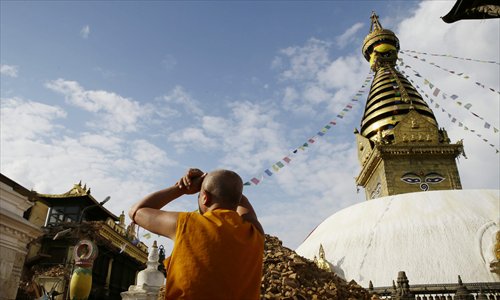HOME >> ARTS
Quake deals heavy blow
Source:AFP Published: 2015-4-27 17:18:01

A monk inspects the damage at Nepalese heritage site Syambhunaath Stupa, also known as monkey temple, after a powerful earthquake struck Nepal, in Kathmandu, Nepal, on April 26. Photo: IC
Reduced to piles of rubble and splintered wood, Nepal's rich cultural heritage has suffered a devastating blow from a massive earthquake that tore through the country, experts said Sunday.
In the heart of Kathmandu, many of a cluster of temples and statues built between the 12th and 18th centuries by the ancient kings of Nepal have collapsed, killing scores and trapping others underneath.
The nine-storey Dharahara tower, a major tourist attraction in the city's Durbar square with its spiral staircase of 200 steps, was reduced to just its base when the 7.8-magnitude quake struck at lunchtime on Saturday.
"I had just bought tickets to climb the tower and was at its base when I felt a sudden shaking," Dharmu Subedi, 36, said from a hospital bed in Kathmandu.
"Within minutes, the Dharahara had crumbled to the ground with maybe more than 100 people in it," Subedi told AFP.
UNESCO was trying to gather information on the extent of the destruction, including at three palace-filled squares in the cities of Patan and Bhaktapur, both former kingdoms in the Kathmandu Valley, as well as in Kathmandu.
"We understand the historic Durbar squares of Kathmandu, Patan and Bhaktapur have been badly damaged," Christian Manhart, UNESCO's representative to Nepal, told AFP.
"Several temples have collapsed. Two temples in Patan have been completely collapsed, and Durbar Square (in Kathmandu) is worse.
"Right now we are assessing the situation, and collecting information on what the damage is. All UN agencies have received a request from the (Nepalese) government for assistance," he added.
He said it was too early to talk about reconstruction of the monuments and how much assistance UNESCO could provide.
Manhart said his office was also trying to determine whether another UNESCO World Heritage site, that of Lumbini, the place where Buddha was born more than 2,600 years ago, had also been hit.
"We haven't received reports of severe damage in Lumbini, but we are still trying to collect information," he said of the site, some 280 kilometers (170 miles) west of Kathmandu.
In Kathmandu, residents were seen clawing through the rubble, using their hands, buckets and shovels to try to find those feared trapped in Durbar Square.
Read more in Special Coverage:

Posted in: Culture & Leisure